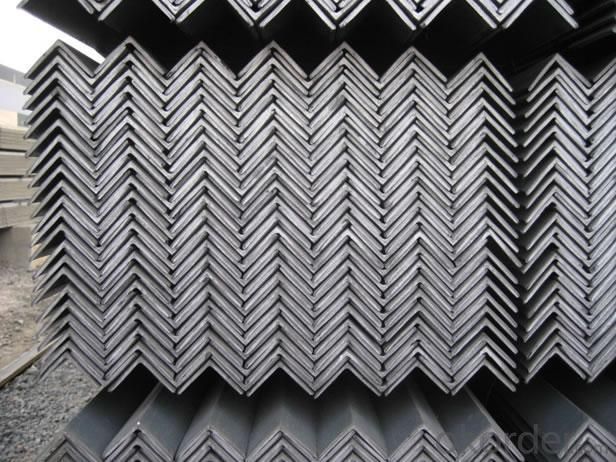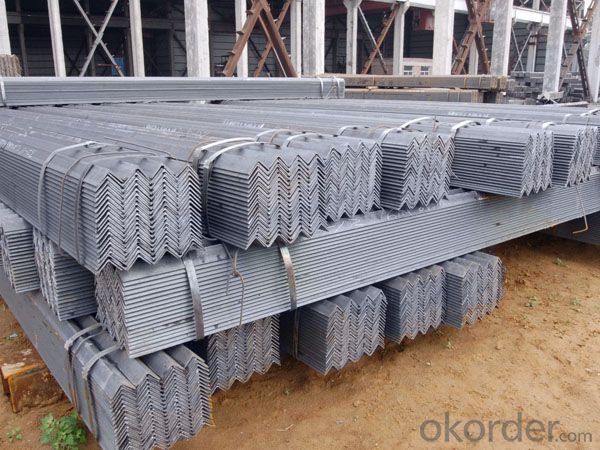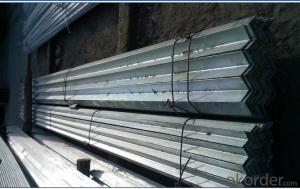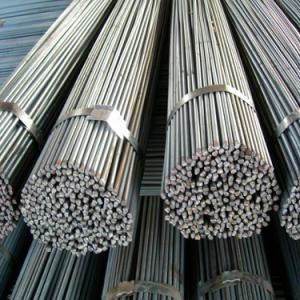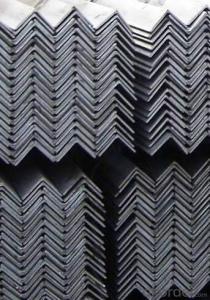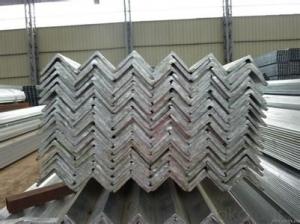ANGLE STEEL HIGH QUALITY HOT ROLLED 20-250MM GB Standard
- Loading Port:
- Tianjin
- Payment Terms:
- TT OR LC
- Min Order Qty:
- 25 m.t.
- Supply Capability:
- 20000000 m.t./month
OKorder Service Pledge
OKorder Financial Service
You Might Also Like
Specification
Product Description:
OKorder is offering ANGLE STEEL HIGH QUALITY HOT ROLLED 20-250MM GB Standard at great prices with worldwide shipping. Our supplier is a world-class manufacturer of steel, with our products utilized the world over. OKorder annually supplies products to European, North American and Asian markets. We provide quotations within 24 hours of receiving an inquiry and guarantee competitive prices.
Product Applications:
According to the needs of different structures, Angle can compose to different force support component, and also can be the connections between components. It is widely used in various building structures and engineering structures such as roof beams, bridges, transmission towers, hoisting machinery and transport machinery, ships, industrial furnaces, reaction tower, container frame and warehouse etc
Product Advantages:
OKorder's ANGLE STEEL HIGH QUALITY HOT ROLLED 20-250MM GB Standard are durable, strong, and resist corrosion.
Main Product Features:
· Premium quality
· Prompt delivery & seaworthy packing (30 days after receiving deposit)
· Corrosion resistance
· Can be recycled and reused
· Mill test certification
· Professional Service
· Competitive pricing
Product Specifications:
Manufacture: Hot rolled
Grade: Q195 – 235
Certificates: ISO, SGS, BV, CIQ
Length: 6m – 12m, as per customer request
Packaging: Export packing, nude packing, bundled
Sizes: 25mm-250mm | ||||||||||||
a*t | ||||||||||||
25*2.5-4.0 | 70*6.0-9.0 | 130*9.0-15 | ||||||||||
30*2.5-6.6 | 75*6.0-9.0 | 140*10-14 | ||||||||||
36*3.0-5.0 | 80*5.0-10 | 150*10-20 | ||||||||||
38*2.3-6.0 | 90*7.0-10 | 160*10-16 | ||||||||||
40*3.0-5.0 | 100*6.0-12 | 175*12-15 | ||||||||||
45*4.0-6.0 | 110*8.0-10 | 180*12-18 | ||||||||||
50*4.0-6.0 | 120*6.0-15 | 200*14-25 | ||||||||||
60*4.0-8.0 | 125*8.0-14 | 250*25 | ||||||||||
FAQ:
Q1: Why buy Materials & Equipment from OKorder.com?
A1: All products offered byOKorder.com are carefully selected from China's most reliable manufacturing enterprises. Through its ISO certifications, OKorder.com adheres to the highest standards and a commitment to supply chain safety and customer satisfaction.
Q2: How do we guarantee the quality of our products?
A2: We have established an advanced quality management system which conducts strict quality tests at every step, from raw materials to the final product. At the same time, we provide extensive follow-up service assurances as required.
Q3: How soon can we receive the product after purchase?
A3: Within three days of placing an order, we will begin production. The specific shipping date is dependent upon international and government factors, but is typically 7 to 10 workdays.

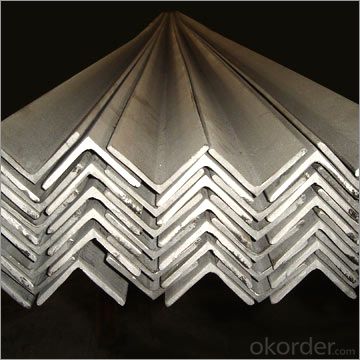
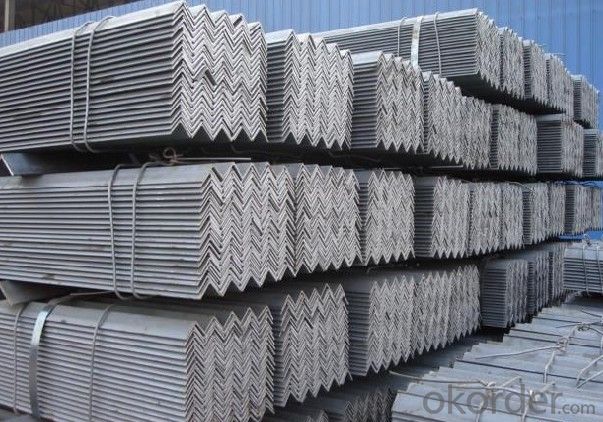
- Q: Can steel angles be used in the construction of warehouses?
- Indeed, warehouses can utilize steel angles for their construction. Owing to their robustness and endurance, steel angles are frequently employed as structural elements in buildings and warehouses. They offer stability and bolster the entire structure, rendering them appropriate for diverse construction purposes. In the realm of warehouse construction, steel angles serve as framing components, columns, beams, and supports, contributing to the establishment of a sturdy and dependable edifice. Furthermore, steel angles exhibit adaptability and can be readily tailored and manufactured to satisfy precise design specifications, thus establishing their prominence as a favored option in warehouse construction ventures.
- Q: What are the different types of connections used for steel angles?
- There are several types of connections that can be used for steel angles, depending on the specific application and load requirements. Some common types of connections include: 1. Welded Connection: This is the most common type of connection used for steel angles. It involves welding the angle to the connected members, such as beams or columns. Welded connections provide high strength and stiffness, making them suitable for heavy loads and structural applications. 2. Bolted Connection: In this type of connection, steel angles are bolted to the connected members using bolts and nuts. Bolted connections are preferred when disassembly or relocation of the structure is anticipated. They offer flexibility in terms of adjustability and ease of installation. 3. Riveted Connection: Riveting involves joining the steel angle to the connected members using rivets. Although not as commonly used nowadays, riveted connections were widely used in older structures. They provide good strength and durability but require skilled labor for installation. 4. Clip Connection: A clip connection is a type of bolted connection where a clip or bracket is used to connect the steel angle to the supporting member. This allows for easy assembly and disassembly, making it suitable for temporary structures or situations requiring frequent modifications. 5. Shear Connection: In shear connections, the steel angle is connected to the supporting member using shear plates or angles. Shear connections are primarily used to transfer shear forces between members and provide sufficient strength and rigidity. 6. Cleat Connection: Cleat connections involve using a cleat plate, typically welded or bolted, to connect the steel angle to the supporting member. Cleat connections are commonly used in industrial applications where heavy loads and high forces need to be transferred. It is important to consider the specific requirements of the structure, such as load capacity, design codes, and environmental conditions, when selecting the appropriate type of connection for steel angles. Additionally, consulting with a structural engineer or referring to the relevant design standards can ensure the proper selection and installation of the connection.
- Q: Can steel angles be used for framing or supporting suspended ceilings?
- Yes, steel angles can be used for framing or supporting suspended ceilings. Steel angles are commonly used in construction for their strength and durability. They provide structural support and stability, making them suitable for framing and supporting suspended ceilings. Steel angles can be attached to walls or ceilings to create a framework for the suspended ceiling system. They are often used in conjunction with other materials such as hangers, wires, and channels to create a secure and stable structure for the suspended ceiling. Additionally, steel angles can be customized and cut to specific lengths and sizes, making them versatile for various framing and supporting applications.
- Q: Can steel angles be used for supports in construction?
- Yes, steel angles can be used for supports in construction. Steel angles are commonly used as structural components in building construction to provide support and stability. They are versatile, durable, and can be easily fabricated and installed, making them suitable for various applications in construction projects.
- Q: Are steel angles prone to rust or corrosion?
- Steel angles have a tendency to rust or corrode. When steel comes into contact with oxygen and moisture, it undergoes a chemical reaction known as oxidation, which leads to the creation of iron oxide, commonly referred to as rust. This reaction can gradually weaken the structural strength of the steel angles. To prevent or reduce rust and corrosion, it is common practice to coat steel angles with protective layers such as paint, galvanization, or other anti-corrosion treatments. It is essential to regularly perform maintenance and inspections to promptly detect and address any indications of rust or corrosion in order to extend the lifespan and optimize the performance of steel angles.
- Q: What are the different types of connections used for steel angles in educational institutions?
- In educational institutions, there are several types of connections used for steel angles. These connections serve to join steel angles together in various applications and structural configurations. Some of the common types of connections used are: 1. Welded Connections: Welding is a widely used method to connect steel angles in educational institutions. It involves melting and fusing the steel angles together using heat, creating a strong and durable connection. Welded connections are often used in structural applications where high strength and rigidity are required. 2. Bolted Connections: Bolted connections involve using bolts, nuts, and washers to secure steel angles together. This type of connection allows for easy disassembly and reassembly, making it suitable for applications where flexibility and adjustability are desired. Bolted connections are commonly used in non-structural applications like furniture, handrails, and brackets. 3. Riveted Connections: Riveting is an older method of connection, where steel angles are joined using rivets. Rivets are inserted through pre-drilled holes in the angles and then hammered or compressed to secure the connection. Although not as commonly used today, riveted connections can still be found in some older structures within educational institutions. 4. Clip Connections: Clip connections involve using specially designed clips or brackets to connect steel angles together. These clips are typically bolted or welded to the angles, providing a quick and efficient method of connection. Clip connections are often used in applications where easy installation and maintenance are important, such as suspended ceilings or modular structures. 5. Gusset Plate Connections: Gusset plate connections involve using additional steel plates (gusset plates) to connect steel angles. The gusset plates are typically welded or bolted to the angles, providing additional strength and stability to the connection. This type of connection is commonly used in heavy-duty structural applications, such as trusses or frames, within educational institutions. Overall, the selection of the type of connection for steel angles in educational institutions depends on factors such as the load requirements, structural design, ease of installation, and maintenance considerations. It is essential to consult with structural engineers and follow applicable building codes and regulations to ensure safe and appropriate connections are used.
- Q: How do steel angles perform in terms of impact resistance?
- Steel angles generally perform well in terms of impact resistance. Due to their structural design, steel angles are able to withstand high impact forces and distribute them evenly across their length. This makes them suitable for applications where impact or dynamic loads are expected, such as in construction, industrial machinery, or automotive frames. The high strength and toughness of steel also contribute to its excellent impact resistance. Steel angles are typically made from low carbon steel or alloy steel, which are known for their high tensile strength and ability to absorb energy without fracturing. This enables steel angles to resist deformation and maintain their structural integrity even under heavy impact. Furthermore, steel angles can be further improved in terms of impact resistance by using specific steel grades or by applying surface treatments such as galvanization or powder coating. These treatments can enhance the corrosion resistance and overall durability of steel angles, making them even more resistant to impact and other harsh environmental conditions. However, it is important to note that the specific impact resistance of steel angles can vary depending on factors such as the dimensions, thickness, and material properties of the angle. Therefore, it is recommended to consult with a structural engineer or refer to technical specifications provided by manufacturers to ensure that the steel angle chosen is suitable for the intended application and expected impact loads.
- Q: Are steel angles resistant to termites and pests?
- No, steel angles are not susceptible to termite and pest infestations as they are made of inorganic materials.
- Q: How do you join steel angles together?
- There exists a range of methods for joining steel angles together, depending on the specific circumstances and requirements. Presented here are some commonly utilized techniques: 1. Welding: A popular and effective method for joining steel angles is welding. This process involves melting the edges of the angles and fusing them together using a welding machine. Welding yields robust and enduring connections, albeit necessitating skilled personnel and adherence to safety precautions. 2. Bolting: Another commonly employed method for joining steel angles is bolting. This approach entails utilizing bolts, nuts, and washers to connect the angles. Bolting provides a secure connection and allows for disassembly, if necessary. It is relatively straightforward and does not demand specialized equipment. 3. Riveting: A traditional method for connecting steel angles is riveting. This method necessitates drilling holes in the angles and using a rivet gun to secure the rivets. Riveting results in a sturdy and permanent connection. 4. Adhesive bonding: Adhesive bonding involves using a potent adhesive to join steel angles. This method is suitable for lightweight applications and offers the advantage of not requiring heat or specialized equipment. However, it may not be ideal for heavy-duty or high-stress applications. When selecting the appropriate method for joining steel angles, it is crucial to consider factors such as load-bearing capacity, structural integrity, aesthetic requirements, and environmental conditions. Consulting with a professional engineer or fabricator can further ensure the selection of the most suitable joining method for one's specific needs.
- Q: How do you determine the required angle length for a specific application?
- To determine the required angle length for a specific application, there are several factors that need to be considered. Firstly, the purpose of the angle in the application needs to be identified. Is it going to be used for structural support, bracing, or as a decorative element? This will help determine the level of strength and stability required, which in turn will influence the length of the angle. Next, the load or weight that the angle needs to bear should be assessed. Understanding the amount of force or pressure that will be applied to the angle will help determine the appropriate length. A heavier load may require a longer angle to distribute the weight effectively and prevent any bending or failure. The material of the angle is another important consideration. Different materials have varying levels of strength and durability. For example, steel angles are stronger than aluminum angles. The material's properties, such as tensile strength and resistance to corrosion, will impact the length required for the specific application. Additionally, the specific geometry and configuration of the application should be taken into account. Factors such as the overall dimensions, desired angle of inclination, and any additional supports or attachments need to be considered. These factors may influence the length needed to ensure proper fit, function, and stability. Finally, industry standards and regulations should be consulted to ensure compliance and safety. Certain applications may have specific guidelines for the length of angles to be used, especially in fields like construction or engineering. Overall, determining the required angle length for a specific application requires a comprehensive analysis of the purpose, load, material, geometry, and relevant standards. Consulting with experts or engineers in the field can also provide valuable insights and guidance.
Send your message to us
ANGLE STEEL HIGH QUALITY HOT ROLLED 20-250MM GB Standard
- Loading Port:
- Tianjin
- Payment Terms:
- TT OR LC
- Min Order Qty:
- 25 m.t.
- Supply Capability:
- 20000000 m.t./month
OKorder Service Pledge
OKorder Financial Service
Similar products
Hot products
Hot Searches
Related keywords



